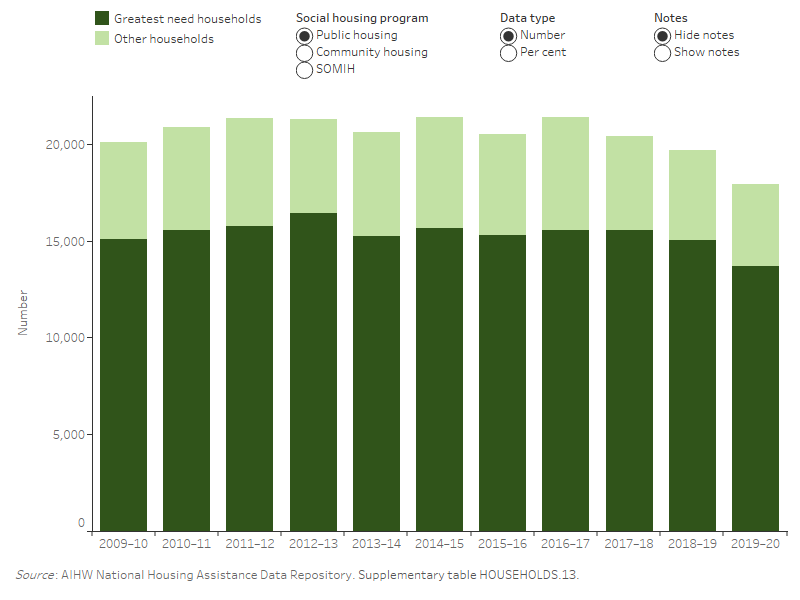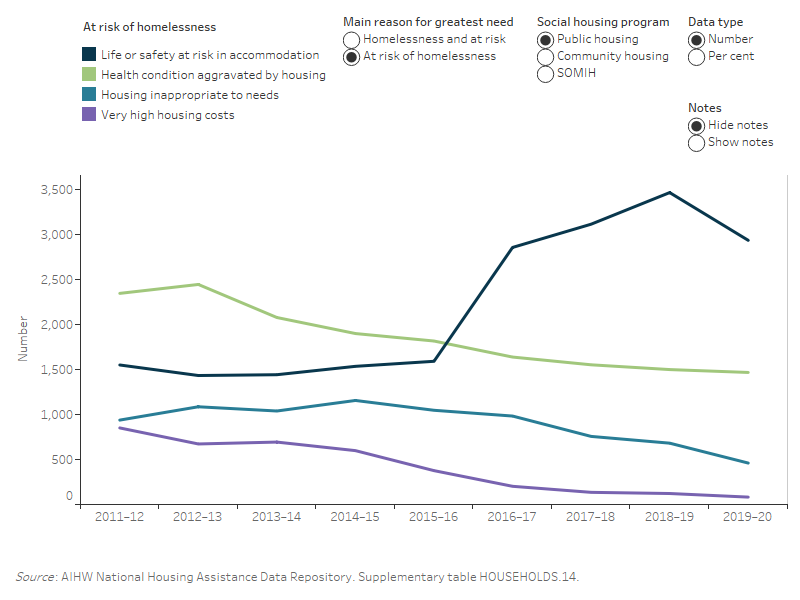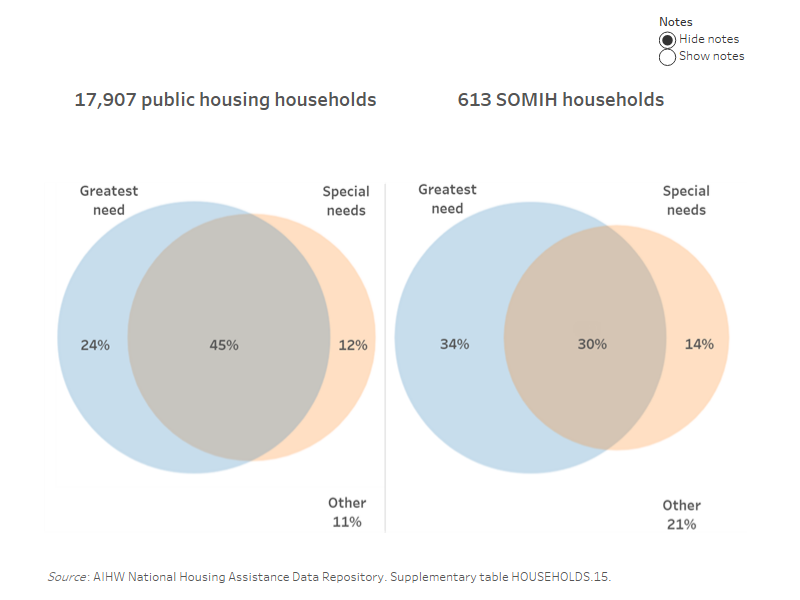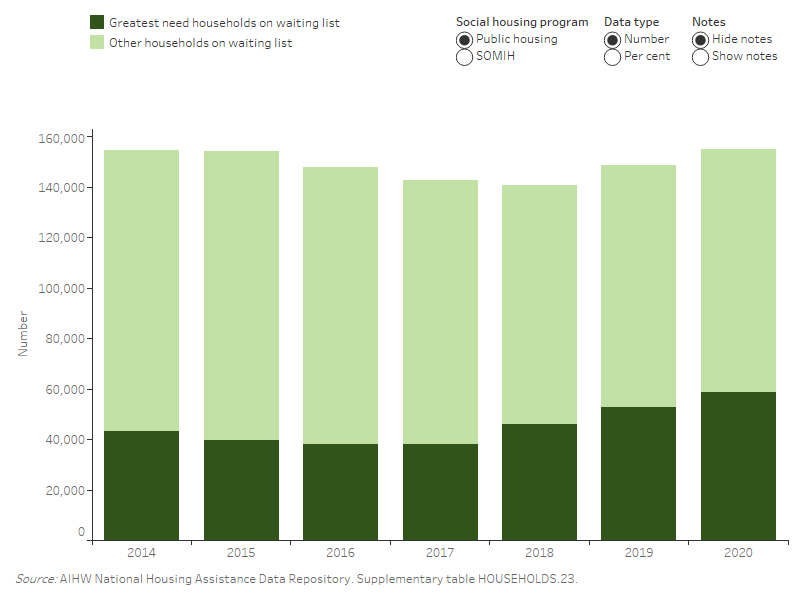Priority groups and waiting lists
On this page
Quick facts
- The majority of new housing allocations were provided to those in greatest need; 76% of new housing allocations in public housing, 65% in SOMIH and 82% in community housing.
- Half (51%, or around 7,000 households) of the newly allocated greatest need households were experiencing homelessness prior to commencing their public housing tenancy in 2019–20. A further 36% were at risk of homelessness.
- Households in greatest need spent less time on waiting lists than other households. Of the greatest need households, over 2 in 5 (42%) newly allocated public housing households and more than half (52%) of newly allocated SOMIH households were allocated housing in less than 3 months.
Historically, social housing has been targeted towards low income families but, in recent years, the focus has shifted towards supporting a highly diverse range of vulnerable groups such as those experiencing trauma, disadvantage and/or financial instability (Groenhart et al. 2014).
Entry into social housing is determined by policies for eligibility and entitlement (e.g. type and location of the property) (Powell et al. 2019). Social housing is generally allocated according to priority needs, with allocations made on the basis of identifying those people with the greatest need (e.g. people experiencing homelessness) and those with special needs for housing assistance (e.g. people with disability).
Data on household need status for Indigenous community housing were not available.
Greatest need households
Public housing, SOMIH and community housing programs prioritise household allocations by assessing their greatest need status (SCRGSP 2021). People experiencing homelessness are identified as being in greatest need, but so too are those with the severest of living circumstances, who are deemed to be ‘at risk of homelessness’ and therefore also in greatest need (Powell et al. 2019).
Assessing greatest need status
Greatest need applies to households if, at the time of allocation, household members were subject to one or more of the following circumstances:
- they were experiencing homelessness
- they were at risk of homelessness, including:
- their life or safety was threatened within existing accommodation
- a health condition was exacerbated by existing accommodation
- their existing accommodation was inappropriate to their needs
- they were experiencing very high rental costs.
For more information, see METeOR.
States and territories may use different criteria for classification of greatest need.
New allocations for Greatest need households
In 2019–20, the majority of new public housing allocations were households in greatest need (76%, or 13,700 households), fluctuating between 73–76% from 2009–10 to 2019–20 (Figure PRIORITY.1) (Supplementary table HOUSEHOLDS.13).
Figure PRIORITY 1: Newly allocated households, by greatest need status and social housing program, 2009–10 to 2019–20
Figure PRIORITY.1: Newly allocated households, by greatest need status and social housing program, 2009–10 to 2018–19. This vertical stacked bar graph shows, for public housing, community housing and SOMIH, the number of greatest needs households was higher than the number of other households, from 2009–10 to 2019–20. In 2019–20, the majority of new public housing allocations were provided to households in greatest need (76%). Between 2009–10 and 2019–20, this proportion fluctuated between 73–82%. In 2009–10, 57% of newly allocated SOMIH dwellings were provided to households in greatest need; this increased to 65% in 2019–20. Prior to 2017–18, the proportion of community housing allocations to households in greatest need was increasing, from 63% in 2009–10 to 86% in 2016–17; the proportion then decreased to 66% in 2018–19. However, in 2019-20 housing allocations to greatest need rose to 82%.

Almost two thirds (65% or 400) of newly allocated SOMIH households were those in greatest need in 2019–20 (excludes Tasmania and the Northern Territory, as greatest need data were not available) (Figure PRIORITY.1) (Supplementary table HOUSEHOLDS.13).
Prior to 2019–20, the proportion of newly allocated community housing households provided to those in greatest need generally increased year to year, from 63% in 2009–10 to 86% in 2016–17. The proportion was lower in both 2018–19 and 2019–20 at 66% and 82%, respectively. Stock transfers over time have affected the number of allocations by greatest need. See the Data quality statement for further information (Supplementary table HOUSEHOLDS.13).
Main reason for greatest need
In 2019–20, of the 13,700 newly allocated public housing households in greatest need (Figure PRIORITY.2) (Supplementary table HOUSEHOLDS.14):
- 51% (7,000 households) were experiencing homelessness at the time of allocation
- 36% (4,900 households) were at risk of homelessness, of those:
- 2,900 reported the main reason for their greatest need was that their life or safety was at risk in their accommodation
- a further 1,500 households reported a health condition aggravated by housing as their main reason.
Figure PRIORITY 2: Newly allocated households in greatest need, by main reason for greatest need and social housing program, 2011–12 to 2019–20
Figure PRIORITY.2: Newly allocated households in greatest need, by main reason for greatest need and social housing program, 2011–12 to 2019–20. This vertical line graph shows the main reason for greatest need of newly allocated households. In 2011–12, the main reason for greatest need in public housing was homelessness (55%); this decreased to 51% in 2019–20. For those at risk of homelessness in public housing, in 2011–12, the main reason for greatest need was health condition aggravated by housing (15%); in 2019–20, the main reason was life or safety at risk in accommodation (21%).

In 2019–20, a higher number of newly allocated SOMIH households in greatest need were experiencing homelessness (47%, or around 190 households) than at risk of homelessness (33%, or around 130 households). A further 20% (80 households) had other or not stated/unknown need status (Supplementary table HOUSEHOLDS.14).
Data on the main reason a household was considered to be in greatest need for community housing were not complete due to data quality issues. Based on the available data, in 2019–20, of the newly allocated greatest need households in community housing where the main reason was known, more households were at risk of homelessness (54%) than experiencing homelessness (44%) (Figure PRIORITY.2) (Supplementary table HOUSEHOLDS.14).
Special needs households
Households seeking social housing often have members with special needs. Some households may have multiple special needs. The definition of special needs is different for the different social housing programs.
Assessing special needs status
For public housing, special needs households include those with:
- a member with disability,
- a main tenant younger than 25 years or older than 75, or
- one or more members who identify as Aboriginal and/or Torres Strait Islander.
As SOMIH is an Indigenous targeted program, Indigenous households in SOMIH are not considered special needs households. For SOMIH, special needs households are only those that have:
- a member with disability or
- a main tenant under 25 years or over 50 (SCRGSP 2021).
New allocations for Special needs households
A household may have more than one 'Special needs' reason. In 2019–20, there were 10,300 newly allocated public housing households with special needs, representing 58% of all newly allocated households. Of these (Supplementary table HOUSEHOLDS.16):
- over half (51%, or 5,300 households) had at least one member with disability
- 2 in 5 (44%, or 4,600 households) had at least one Indigenous member
- 1 in 5 (21%, or 2,200 households) had a main tenant aged under 25
- 6% (almost 600 households) had a main tenant aged 75 or over.
In 2019–20, of the more than 400 newly allocated SOMIH households with special needs:
- over half (54%, or 240 households) had a main tenant aged 50 and over
- 1 in 4 (26%, or 110 households) had a main tenant aged under 25 years
- 2 in 5 (39%, or 170 households) contained at least one member with disability.
Greatest and special needs households
Greatest and special needs categories are not mutually exclusive and one or more household members may be counted in a number of categories within each priority group or across priority groups. Households with members that have both greatest and special needs may be some of the most vulnerable households and may require high levels of care and support.
special needs may be some of the most vulnerable households and may require high levels of care and support.
In 2019–20, of the newly allocated households in public housing (Figure PRIORITY.3) (Supplementary table HOUSEHOLDS.15):
- almost half were both greatest need and special needs households (45%, or 8,100 households)
- almost one-quarter were greatest need only (no special needs) (24% or 4,400)
- almost 1,200 (7%) were neither greatest need nor special needs households.
In 2019–20, of the newly allocated households in SOMIH:
- 3 in 10 (30%, or 180 households) were both greatest need and special needs households
- a higher proportion (34% or 210 households) had greatest need only (no special needs)
- almost one-fifth (18% or 110) were neither greatest need nor special needs.
Figure PRIORITY.3: Newly allocated households (per cent), by greatest need and/or special needs status, by public housing and SOMIH, 2019–20
Figure PRIORITY.3: Newly allocated households (per cent), by greatest need and/or special needs status, for public housing and SOMIH, 2019–20. The Venn diagram shows the overlap of greatest needs and special needs newly allocated households in public housing and SOMIH. In 2019–20, of the newly allocated households in public housing, 24% had greatest needs only, 12% had special needs only and 45% were both greatest needs and special needs households. Of the newly allocated households in SOMIH, 34% had greatest needs only, 14% had special needs only and 30% were both greatest needs and special needs households.

Waiting lists
Fluctuations in the numbers of people on waiting lists are not necessarily measures of changes in underlying demand for social housing. A number of factors may influence the length of waiting lists including changes to allocation policies, priorities and eligibility criteria put in place by state/territory housing authorities (Dockery et al. 2008). Further, some people who wish to access social housing may not apply due to the long waiting times or lack of available options in their preferred location. It is also important to note that in some states/territories, applicants may be on more than one waiting list and, as such, combined figures are expected to be an overestimate of the total. For further details, see the Data quality statements.
Waiting list data for both community housing and Indigenous community housing were unavailable.
Access to social housing is managed using waiting lists, with priority given to those considered to be high priority applicants (see above for information about Greatest need and Special needs household).
At 30 June 2020, the number of households on the waiting list (excluding transfers) were (FIGURE WAITING LIST.1) (Supplementary table HOUSEHOLDS.23):
- 155,100 households on a waiting list for public housing (up from 154,600 at 30 June 2014)
- 10,900 households on a waiting list for SOMIH dwellings (up from 8,000 at 30 June 2014).
Of those applicants on the waiting list at 30 June 2020 ):
- there were 58,500 new greatest need households on the waiting list for public housing; an increase from 43,200 at 30 June 2014.
- there were almost 4,400 new greatest need households waiting for SOMIH dwellings, up from 3,800 at 30 June 2014.
Figure WAITING LIST.1: Households on waiting list, by public housing and SOMIH, at 30 June 2014 to 2020
Figure WAITLIST.1: Households on waiting list, by greatest need status, for public housing and SOMIH, 2014 to 2020.This vertical stacked bar graph shows that the number of greatest need households on waiting list has increased for public housing, with 58,500 (38%) in 2020, compared with 43,200 (28%) in 2014. Similarly, the number of other households on waiting list has increased, with 6,500 in 2020, compared with 4,200 in 2014. For SOMIH, the number of greatest need households on the waiting list has increased, with 4,400 (41%) in 2020, compared with 3,800 (48%) in 2014. However, the number of greatest need households on the waiting list has decreased relative to 2019, with 5,700 (47%) compared with 4,400 (41%) in 2020.

State and territory waiting lists
There were some notable differences in the proportion of new greatest need households on the waiting lists among the states and territories. Of the applicants on the waiting list, at 30 June 2020 (Figure PRIORITY.2) (Supplementary table HOUSEHOLDS.24):
- in New South Wales, 5,800 (12%) were new greatest need households on the waiting list for public housing, compared with 18,100 (87%) in Queensland.
- in Queensland, 3,900 (91%) were new greatest need households on the waiting list for SOMIH, compared with 100 (6%) in South Australia.
Glossary
- Dockery A, Ong R, Whelan S & Wood G 2008. The relationship between public housing wait lists, public housing tenure and labour market outcomes. AHURI Research Report No. 9. Melbourne: Australian Housing and Urban Research Institute Limited.
- Groenhart L, Burke T & Ralston L 2014. Thirty years of public housing supply and consumption: 1981–2011. AHURI Final Report No. 231. Melbourne: Australian Housing and Urban Research Institute.
- Powell A, Meltzea A, Martin C, Stone W, Liu E, Flanagan K, Muir K & Tually S 2019. The construction of social housing pathways across Australia. AHURI Final Report No. 316. Melbourne: Australian Housing and Urban Research Institute.
- SCRGSP (Steering Committee for the Review of Government Service Provision) 2021. Report on Government Services 2021 – Housing. Canberra: Productivity Commission.


